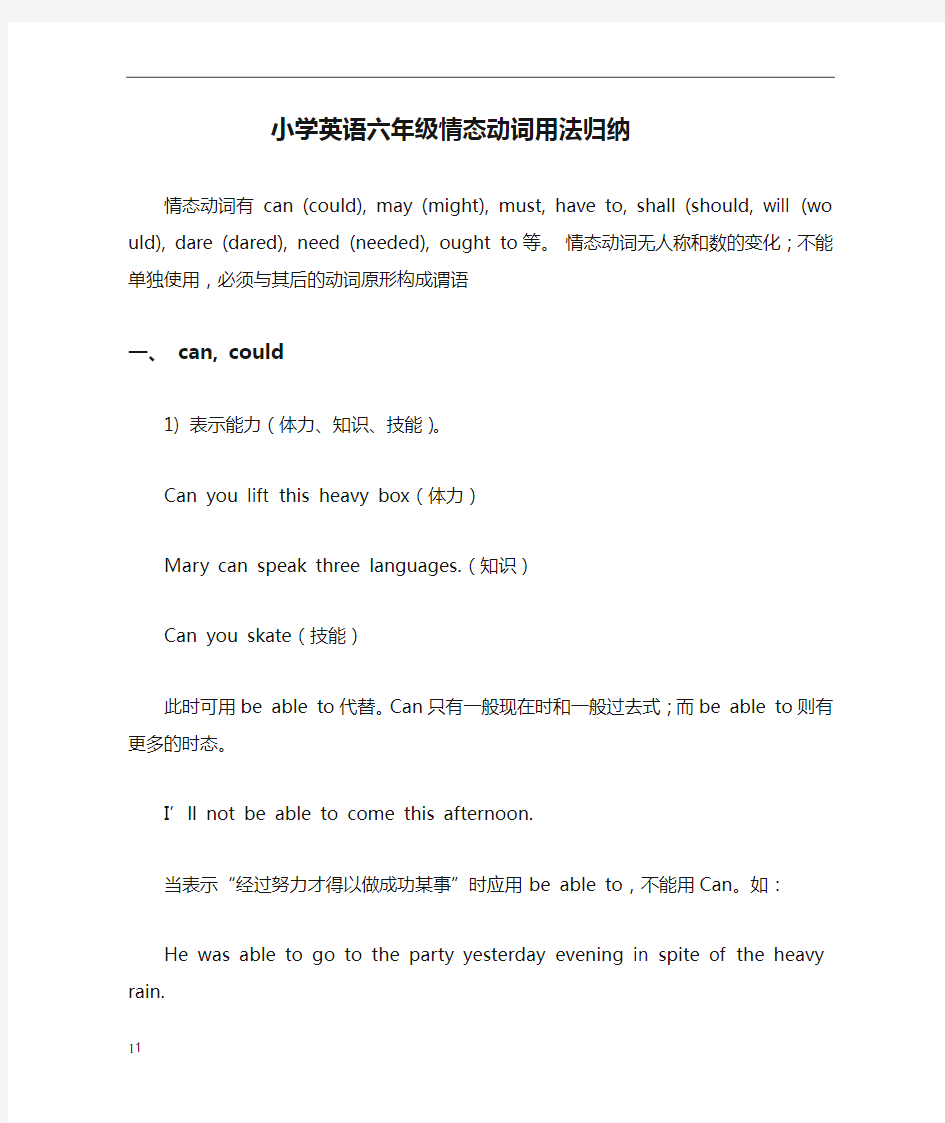

小学英语六年级情态动词用法归纳
情态动词有can (could), may (might), must, have to, shal l (should, will (would), dare (dared), need (needed), ought to等。情态动词无人称和数的变化;不能单独使用,必须与其后的动词原形构成谓语
一、 can, could
1) 表示能力(体力、知识、技能)。
Can you lift this heavy box(体力)
Mary can speak three languages.(知识)
Can you skate(技能)
此时可用be able to代替。Can只有一般现在时和一般过去式;而b e able to则有更多的时态。
I’ll not be able to come this afternoon.
当表示“经过努力才得以做成功某事”时应用be able to,不能用C an。如:
He was able to go to the party yesterday evening in spite o
f the heavy rain.
2) 表示请求和允许。
-----Can I go now
----- Yes, you can. / No, you can’t.
此时可与may互换。在疑问句中还可用could,
might代替,不是过去式,只是语气更委婉,不能用于肯定句和答语中。
---- Could I come to see you tomorrow
---- Yes, you can. ( No, I’m afraid not. )
3) 表示客观可能性(客观原因形成的能力)。
They’ve changed the timetable, so we can go by bus instead.
This hall can hold 500 people at least.
4) 表示推测(惊讶、怀疑、不相信的态度),用于疑问句、否定句和感叹句中。
Can this be true
This can’t be done by him.
How can this be true
二、 may, might
1) 表示请求和允许。might比 may语气更委婉,而不是过去式。否定回答时可用can’t
或mustn’t,表示“不可以,禁止”。
----Might/ May I smoke in this room
---- No, you mustn’t.
---- May/Might I take this book out of the room
---- Yes, you can. (No, you can’t / mustn’t. )
用May I...征徇对方许可时比较正式和客气,而用Can I...在口语中更常见。
2)用于祈使句,表示祝愿。
May you succeed!
3) 表示推测、可能性(不用于疑问句)。
might不是过去式,它所表示的可能性比may小。
1.He may /might be very busy now.
2.Your mother may /might not know the truth.
三、 must, have to
1) 表示必须、必要。
You must come in time.
在回答引出的问句时,如果是否定的,不能用mustn’t(禁止,不准),而用needn’t, don’t have to(不必).
---- Must we hand in our exercise books today
---- Yes, you must.
---- No, you don’t have to / you needn’t.
2) must是说话人的主观看法,而have to则强调客观需要。Must 只有一般现在时, have to 有更多的时态形式。
1.he play isn’t interesting, I really must go now. 2. I had to work when I was your age.
3) 表示推测、可能性(只用于肯定的陈述句)
1.You’re Tom’s good friend, so you must know what he li kes best.
2. Your mother must be waiting for you now.
四、 dare, need
1) dare作情态动词用时, 常用于疑问句、否定句和条件从句中, 过去式形式为dared。
1.How dare you say I’m unfair
2.He daren’t speak English before such a crowd, dare he
3. If we dared not go there that day,we couldn’t get th
e beautiful flowers.
2) need 作情态动词用时, 常用于疑问句、否定句。在肯定句中一般用must, have to, ought to, should代替。
1.You needn’t come so early.
2. ---- Need I finish the work today
---- Yes, you must. / No, you needn’t.
3) dare和 need作实义动词用时,有人称、时态和数的变化。在肯定句中,dare后面常接带to的不定式。在疑问句和否定句中,dare 后面可接带to或不带to的不定式。而need后面只能接带to的不定式。
1. I dare to swim across this river.
2. He doesn’t dare (to) answer.
3. He needs to finish his homework today.
五、 shall, should
1) shall 用于第一人称,征求对方的意见。
What shall we do this evening
2) shall 用于第二、三人称,表示说话人给对方的命令、警告、允诺或威胁。
1. You shall fail if you don’t work hard.(警告)
2. He shall have the book when I finish it.(允诺)
3. He shall be punished.(威胁)
六、 will, would
1) 表示请求、建议等,would更委婉。
Will / Would you pass me the ball, please
2) 表示意志、愿望和决心。
1. I will never do that again.
2. They asked him if he would go abroad.
3) would表示过去反复发生的动作或某种倾向。would表示过去习惯时比used to正式,且没有“现已无此习惯”的含义。
1. During the vacation, he would visit me every other day.
2. The wound would not heal.
4) 表示估计和猜想。
It would be about ten o’clock when she left home.
七、 should, ought to
1) should, ought to表示“应该”,ought to表示义务或责任,比should语气重。
1. I should help her because she is in trouble.
2. You ought to take care of the baby.
2) 表示劝告、建议和命令。should, ought to可通用,但在疑问句中常用should。
1. You should / ought to go to class right away.
2. Should I open the window
3) 表示推测
should , ought to (客观推测), must(主观推测)。
must be home by now. (断定他已到家)
ought to/should be home by now.(不太肯定)
3. This is where the oil must be.(直爽)
4. This is where the oil ought to/should be.(含蓄)
情态动词记忆口诀:
情态动词两要点;动词原形跟后面,说话语气较委婉,can表"能力
"may"许可",must"责任"或"义务",否定回答"needn't"换;should"应该",would"愿",have to "被迫"表客观.
注释:对must构成的一般疑问句作否定回答只能用needn't. can的用法
1. 表能力
Can your sister skate / Can you sing / Can you dance 2. 表示可能性
Can you go with us
We can go there by bus.
3. 表示同意做某事,意为"允许","可以"
You can go now.
Can I have a look at your photos
4. 表推测(主要用于否定句,疑问句)
It can't be Jay Zhou.
He can't be thinking about something.
must的用法
1. 表示按命令,规定,责任等必须要做的事.
You must do all the homework by yourself.
You mustn't park your car here.
在回答由must引导的一般疑问句时,如果表示肯定,用must;如果表示否定,要用needn't.
-Must I come here tomorrow
-Yes, you must.
(No, you needn't.)
2. 表示肯定的推测,意为"一定会","一定是",多用于肯定句. It must belong to Karla.
He must be happy.
You must be joking.
must和have to 的区别是:must表示说话人的主观意愿,而have to 则表示客观要求,意为"不得不".
You must tell us what you have seen.
He had to walk home because the bus had left.
need的用法
need除了可用作行为动词外,还可用作情态动词,作为情态动词使用时,多用于疑问句和否定句,后面直接跟动词原形,作为行为动词时,后面跟带to的动词不定式.
他需要现在去看医生吗
Does he need to see a doctor now
Need he see a doctor now
need作为情态动词,意为"需要",无时态和人称的变化.
They needn't hand in their homework now.
Need I stay with you
(肯定回答为:Yes, you must. 否定回答用No, you needn't.) may的用法
1. 表示"可以",用以询问或说明可否做某事.
May I use your pencil
You may come here tomorrow.
(在回答由may引导的问题时,常以Yes, please或certainly来表示允许或同意,而用please don't 或no, you mustn't来表示不允许和反对.)
2. 用于表推测某事可能发生或某情况可能存在,意为"可能",一般不用于疑问句.
It may rain this afternoon.
She may still be in the classroom.